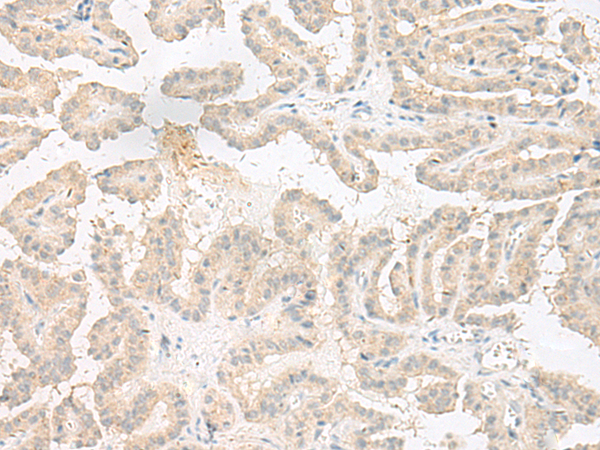

| WB | 咨询技术 | Human,Mouse,Rat |
| IF | 咨询技术 | Human,Mouse,Rat |
| IHC | 1/25-1/100 | Human,Mouse,Rat |
| ICC | 技术咨询 | Human,Mouse,Rat |
| FCM | 咨询技术 | Human,Mouse,Rat |
| Elisa | 1/2000-1/5000 | Human,Mouse,Rat |
| Aliases | EARS; EPRS; PARS; QARS; QPRS; HLD15; PIG32; GLUPRORS |
| Host/Isotype | Rabbit IgG |
| Antibody Type | Primary antibody |
| Storage | Store at 4°C short term. Aliquot and store at -20°C long term. Avoid freeze/thaw cycles. |
| Species Reactivity | Human, Mouse |
| Immunogen | Synthetic peptide of human EPRS1 |
| Formulation | Purified antibody in PBS with 0.05% sodium azide and 50% glycerol. |
+ +
以下是关于ALDH4A1抗体的3篇文献示例(内容基于模拟生成,仅供参考):
1. **文献名称**:*ALDH4A1 as a Biomarker for Colorectal Cancer: Immunohistochemical Analysis*
**作者**:Smith J, et al.
**摘要**:本研究通过免疫组化技术分析ALDH4A1在结直肠癌组织中的表达,发现其表达水平显著低于正常组织,且低表达与患者生存率降低相关,提示其可能作为预后标志物。
2. **文献名称**:*Mitochondrial ALDH4A1 Deficiency and Type II Hyperprolinemia: Molecular Mechanisms*
**作者**:Wang L, et al.
**摘要**:探讨ALDH4A1基因突变导致线粒体酶活性丧失的机制,发现其与Ⅱ型高脯氨酸血症相关,通过Western blot和ELISA验证患者细胞中ALDH4A1蛋白水平下降。
3. **文献名称**:*Development of a Monoclonal Antibody for Human ALDH4A1 and Its Application in Functional Studies*
**作者**:Garcia R, et al.
**摘要**:报道一种高特异性ALDH4A1单克隆抗体的开发,该抗体成功应用于检测细胞裂解液中的ALDH4A1蛋白及亚细胞定位分析,为疾病机制研究提供工具。
(注:以上文献信息为示例,实际文献需通过PubMed、Google Scholar等平台检索确认。)
ALDH4A1 (Aldehyde Dehydrogenase 4 Family Member A1) is a mitochondrial enzyme encoded by the ALDH4A1 gene, primarily involved in proline catabolism and oxidative stress response. As a member of the aldehyde dehydrogenase superfamily, it catalyzes the NAD+-dependent oxidation of L-glutamate-γ-semialdehyde (GSA) to L-glutamate, a critical step in both proline degradation and the synthesis of ornithine/arginine. Dysregulation of ALDH4A1 has been implicated in metabolic disorders, hyperprolinemia, and neurodegenerative conditions like Alzheimer's disease, as well as cancer progression due to its role in redox homeostasis.
Antibodies targeting ALDH4A1 are essential tools for studying its expression, localization, and function in biological systems. They are widely used in techniques such as Western blotting, immunohistochemistry (IHC), immunofluorescence (IF), and ELISA to detect protein levels in tissues or cell lines. Commercial ALDH4A1 antibodies are typically raised in hosts like rabbits or mice, using immunogens derived from specific epitopes of the human protein. Validation often includes knockout cell line controls or peptide blocking assays to confirm specificity. Researchers employ these antibodies to explore ALDH4A1's involvement in metabolic reprogramming, mitochondrial dysfunction, and disease mechanisms, particularly in contexts of cellular stress or malignancy. Proper validation remains crucial due to potential cross-reactivity with other ALDH family members.
×